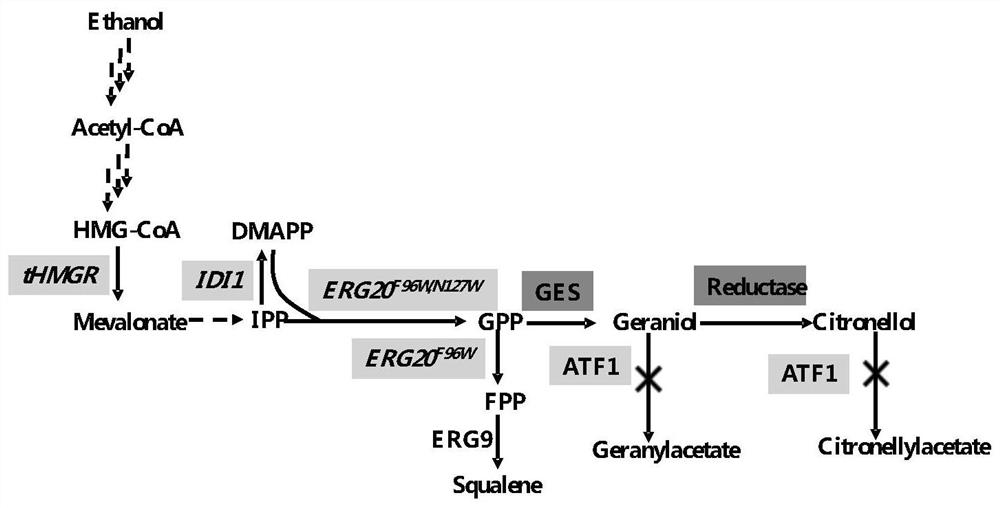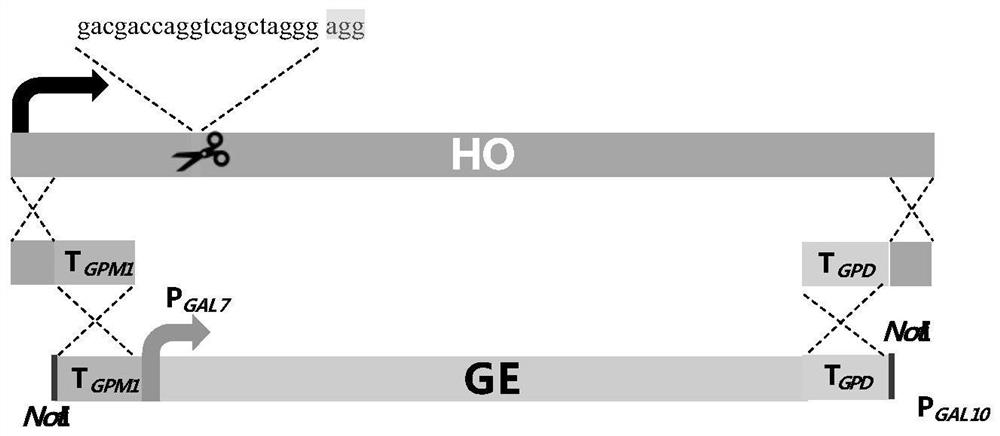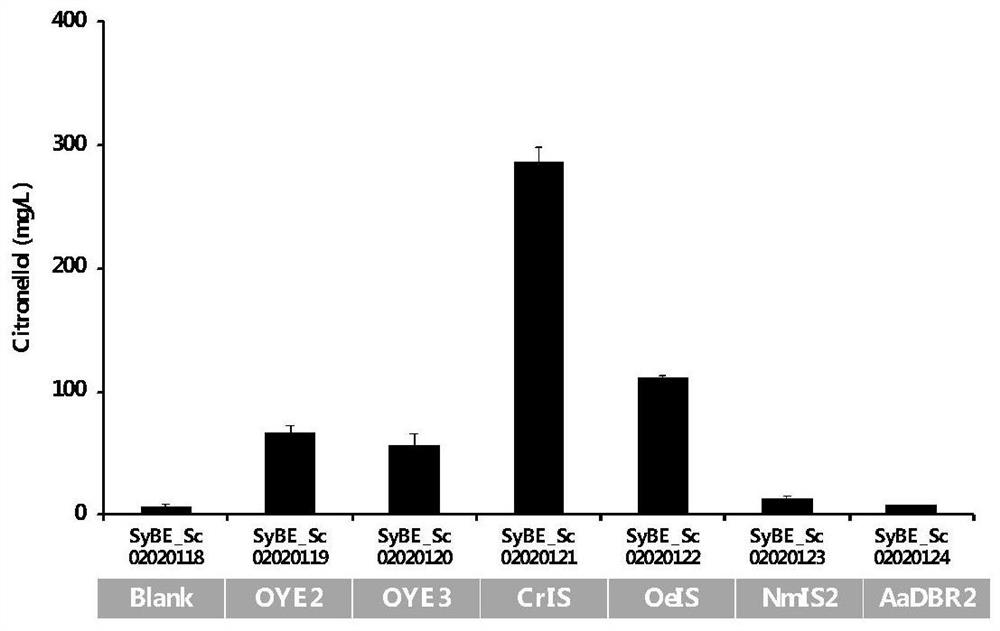Yeast genetically engineered strain for high yield of citronellol as well as construction method and fermentation method of yeast genetically engineered strain
The technology of a genetically engineered strain and a construction method, which is applied to a yeast genetically engineered strain with high citronellol yield and its construction field, can solve the problems of no CPP found, only the verification of enzyme function, low catalytic efficiency, etc., so as to reduce monoterpenes. Cytotoxic, low-cost effect
- Summary
- Abstract
- Description
- Claims
- Application Information
AI Technical Summary
Problems solved by technology
Method used
Image
Examples
Embodiment 1
[0048] Embodiment 1 screening different reductases for synthesizing citronellol
[0049] 1. Acquisition of yeast chassis strains that strengthen the mevalonate pathway
[0050] Provided by Yuan Yingjin's research group, the strain number is SyBE_Sc02020001, the genotype of the strain is CEN.PK2-1C, gal80Δ::tHMG-P GAL1,10 -IDI1-His3.
[0051] 2. Construction of geraniol producing strains
[0052] The production of geraniol is catalyzed by vinca-derived geraniol synthase (CrGES) ( figure 1 ), in order to improve the catalytic efficiency of CrGES in Saccharomyces cerevisiae, its N-terminus was truncated by 43 amino acids, and the gene encoding CrGES was codon-optimized in Saccharomyces cerevisiae. t43CrGES and the gene ERG20 encoding the mutated farnesene synthase were synthesized by overlap extension PCR (OE-PCR). F96W,N127W Fusion together, the two genes are connected by a short flexible linker GSG to obtain the gene t43CrGES-ERG20 F96W,N127W (GE), BsaI enzyme cutting site...
Embodiment 2
[0065] Embodiment 2 The impact of transforming the chassis competition path on the output of citronellol
[0066] 1. The transformation method of competition path
[0067] Although overexpression of ERG20 F96W,N127W can make more precursors flow to citronellol, but wild-type ERG20 (FPP synthase gene) in S. cerevisiae chassis cells still competitively metabolizes the citronellol precursor GPP. In the present invention, ERG20 is mutated into ERG20 in situ by CRISPR-Cas9 technology F96W ( Figure 4). The gRNA used here is GGACTTGTCCATCATATCAT. It was ligated into the Cas9 plasmid digested with BsmBI by primer annealing. When constructing homologous fragments, the OE-PCR method was used to mutate the CGG upstream of the position corresponding to the gRNA on ERG20 to CAG to block the repeated cutting of Cas9. The mutation here is a synonymous mutation, and the 99-position alanine involved is not changes happened. Similarly, the introduction of F96W is also through the method...
Embodiment 4
[0082] Embodiment 4 Fermentation design and optimization of citronellol high-yielding bacterial strain
[0083] 1. Construction of integrated strains
[0084] The endogenous acetyltransferase ATF1 of Saccharomyces cerevisiae can metabolize the substrate geraniol and the product citronellol, so the expression cassette of IDI1-SH3 and SF1 were integrated into the ATF1 site, and the primers were designed to amplify P GAL7 -SF1-T GPD and T FBA1 -P GAL1 -IDI1-SH3-T TDH2 , A 50-60bp homologous sequence with ATF1 was added to the primer as an integrated homologous arm. The PCR product was recovered by DNA gel electrophoresis, and the two fragments were recovered and integrated into the ATF1 position on the SyBE_Sc02020227 genome through the CRISPR-Cas9 system, and the gRNA used was GACTTCGGAATAAACAAGTA. After primary screening by colony PCR, the integrated fragment was amplified with high-fidelity enzymes, and the correct clone was obtained after sequencing to verify that there ...
PUM
 Login to View More
Login to View More Abstract
Description
Claims
Application Information
 Login to View More
Login to View More - R&D
- Intellectual Property
- Life Sciences
- Materials
- Tech Scout
- Unparalleled Data Quality
- Higher Quality Content
- 60% Fewer Hallucinations
Browse by: Latest US Patents, China's latest patents, Technical Efficacy Thesaurus, Application Domain, Technology Topic, Popular Technical Reports.
© 2025 PatSnap. All rights reserved.Legal|Privacy policy|Modern Slavery Act Transparency Statement|Sitemap|About US| Contact US: help@patsnap.com



